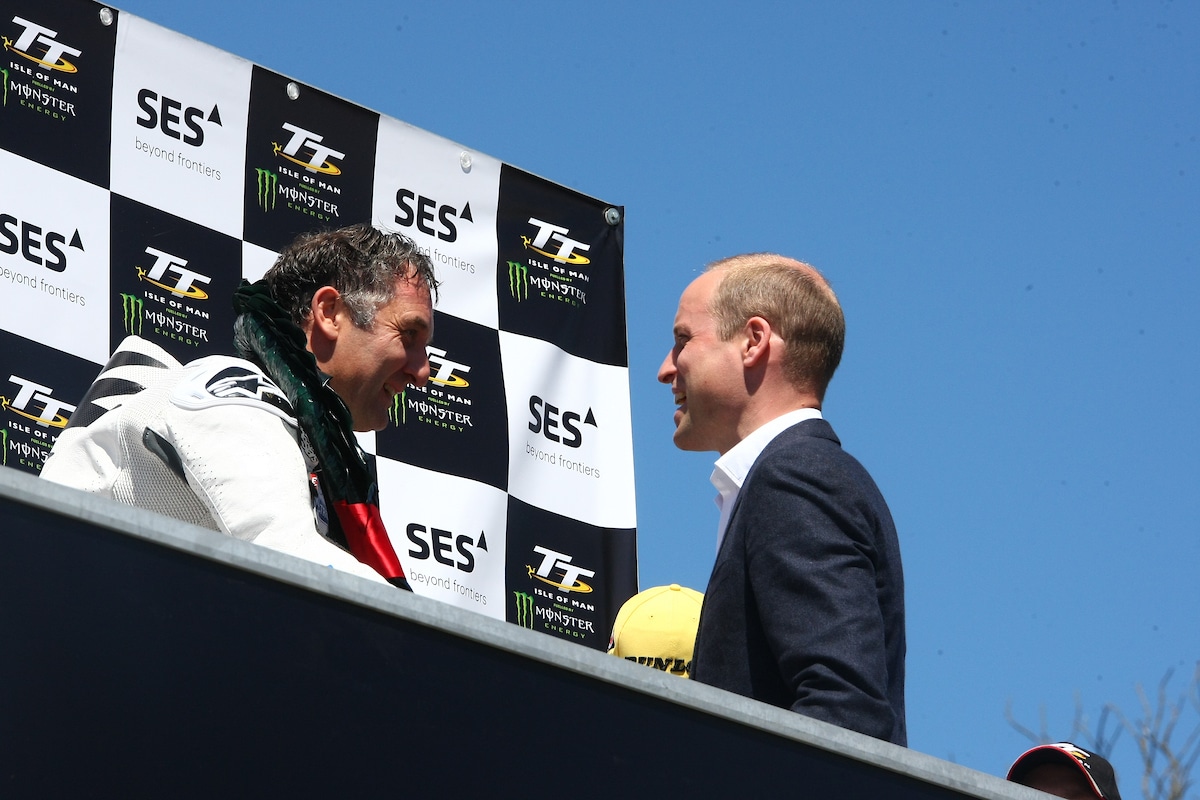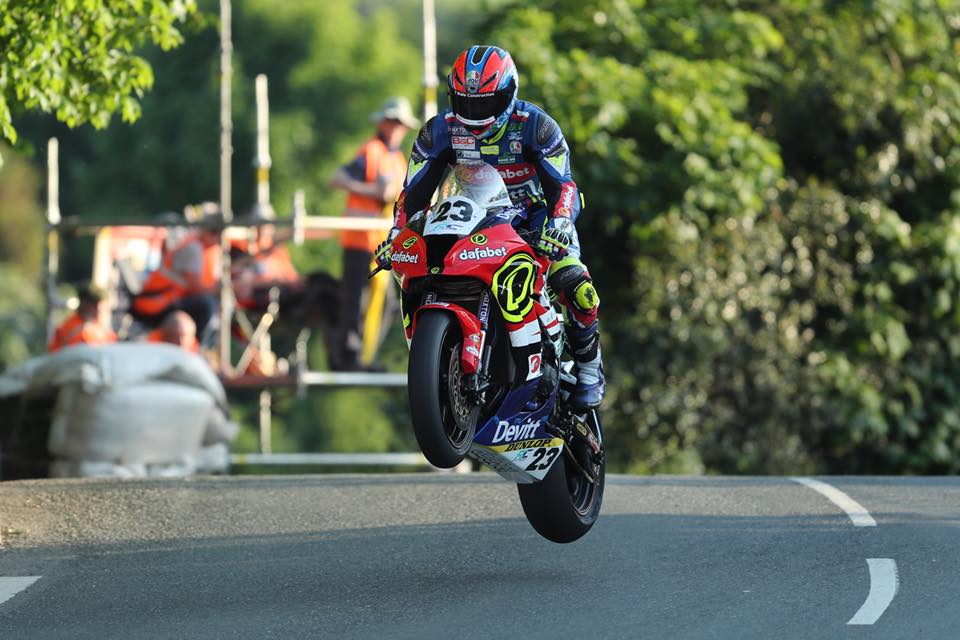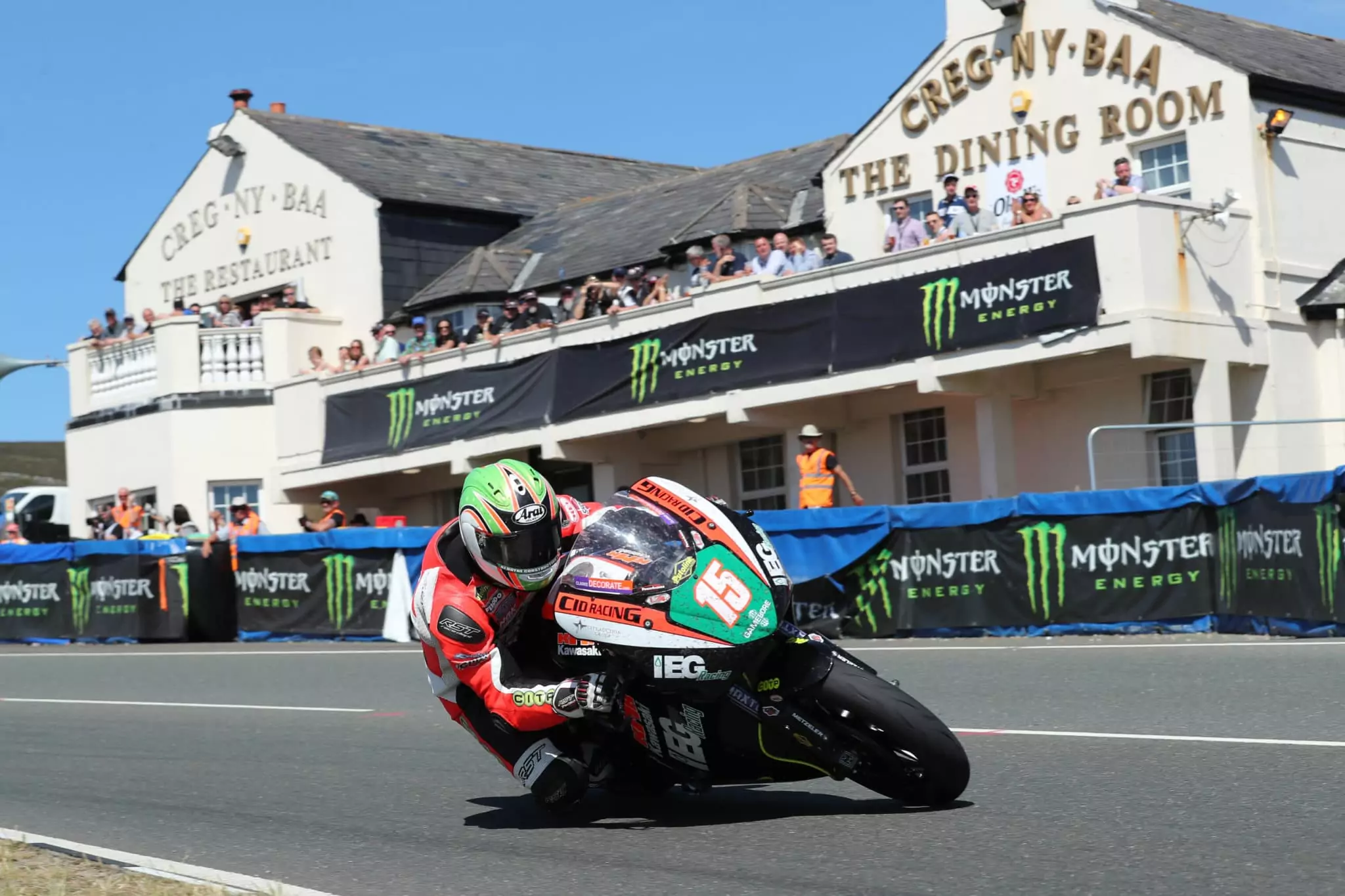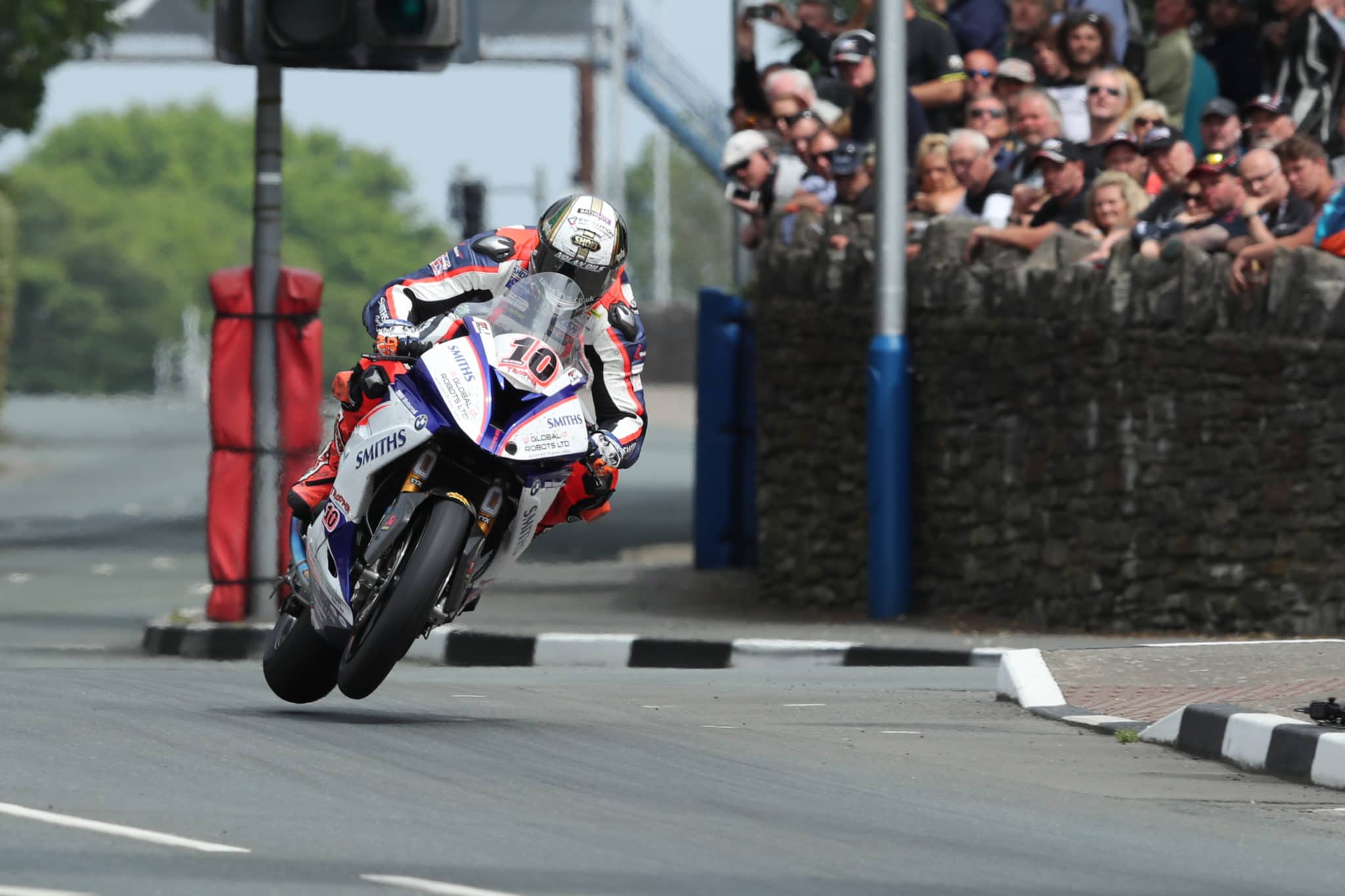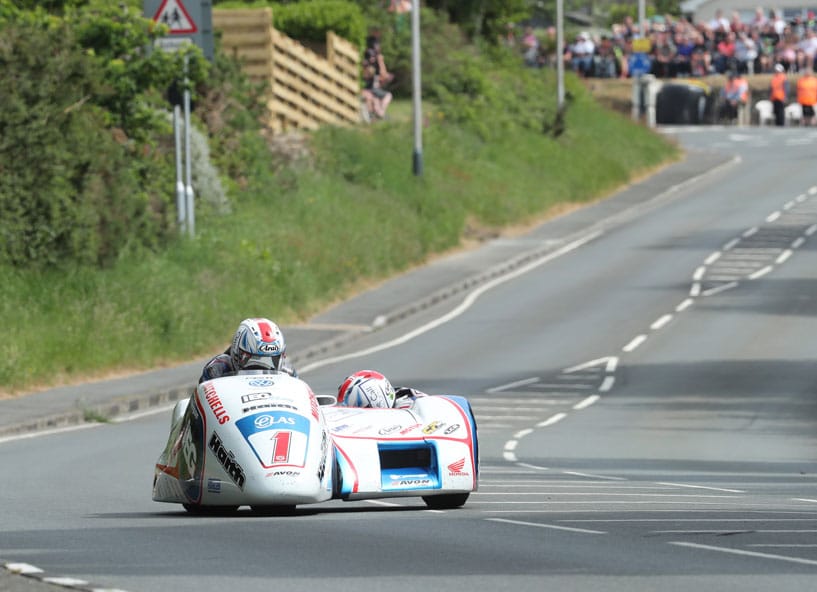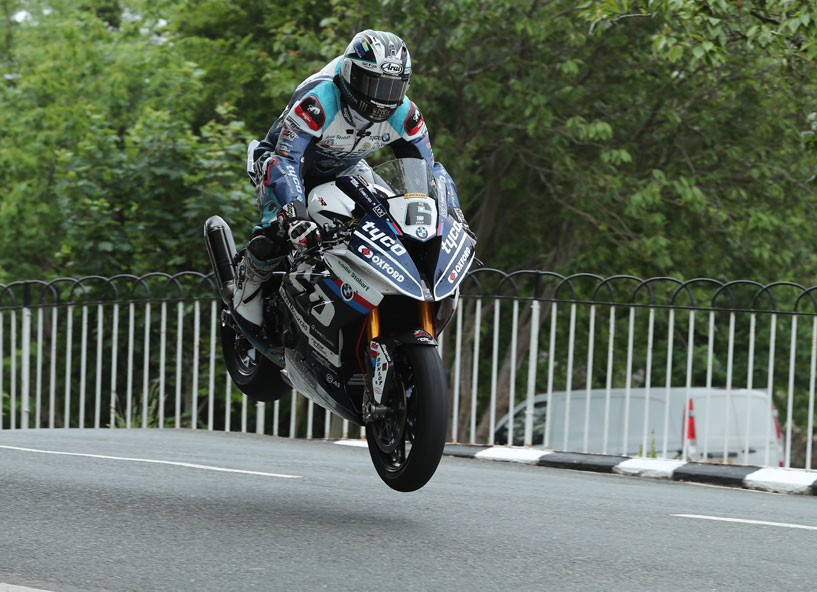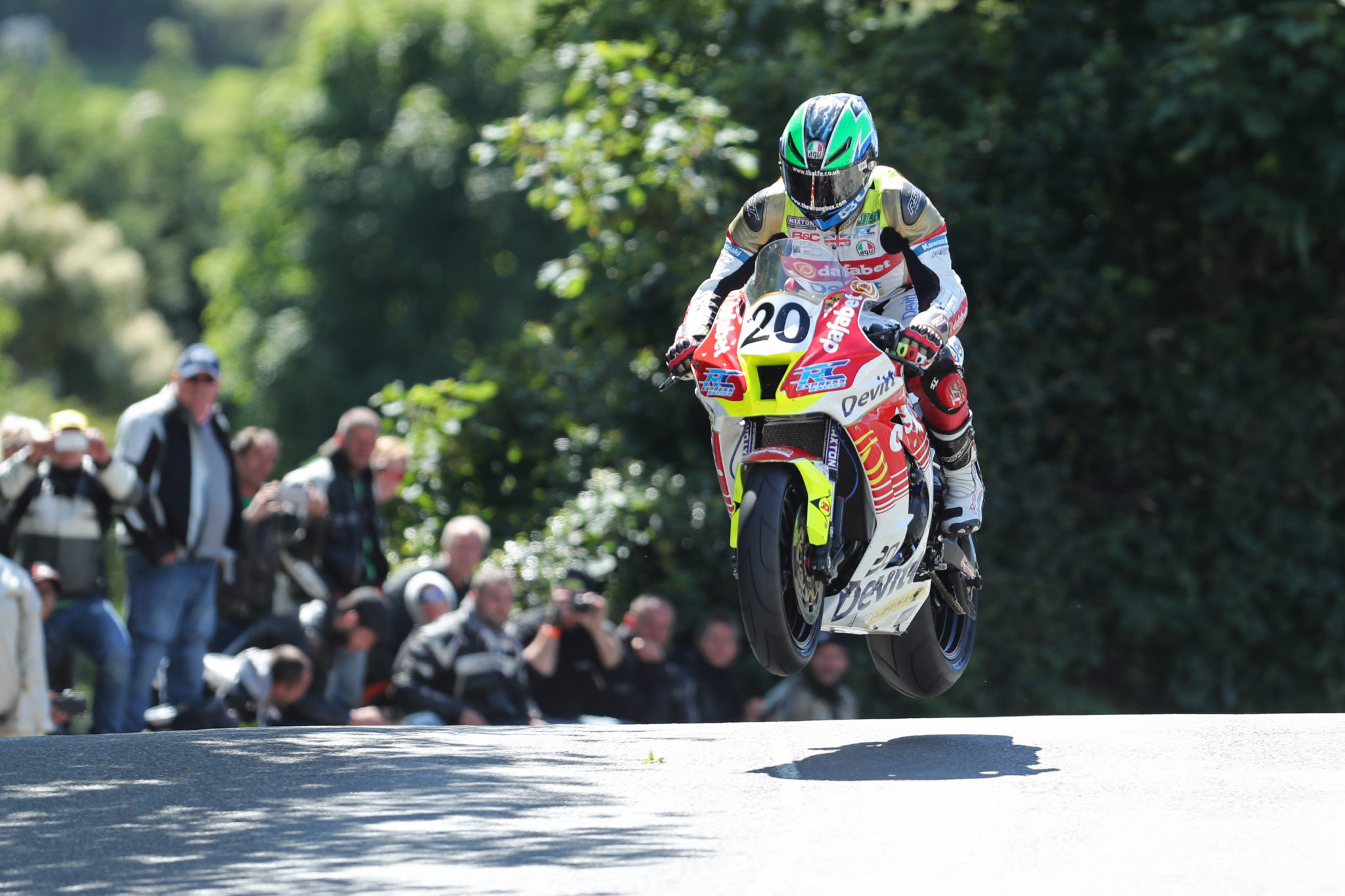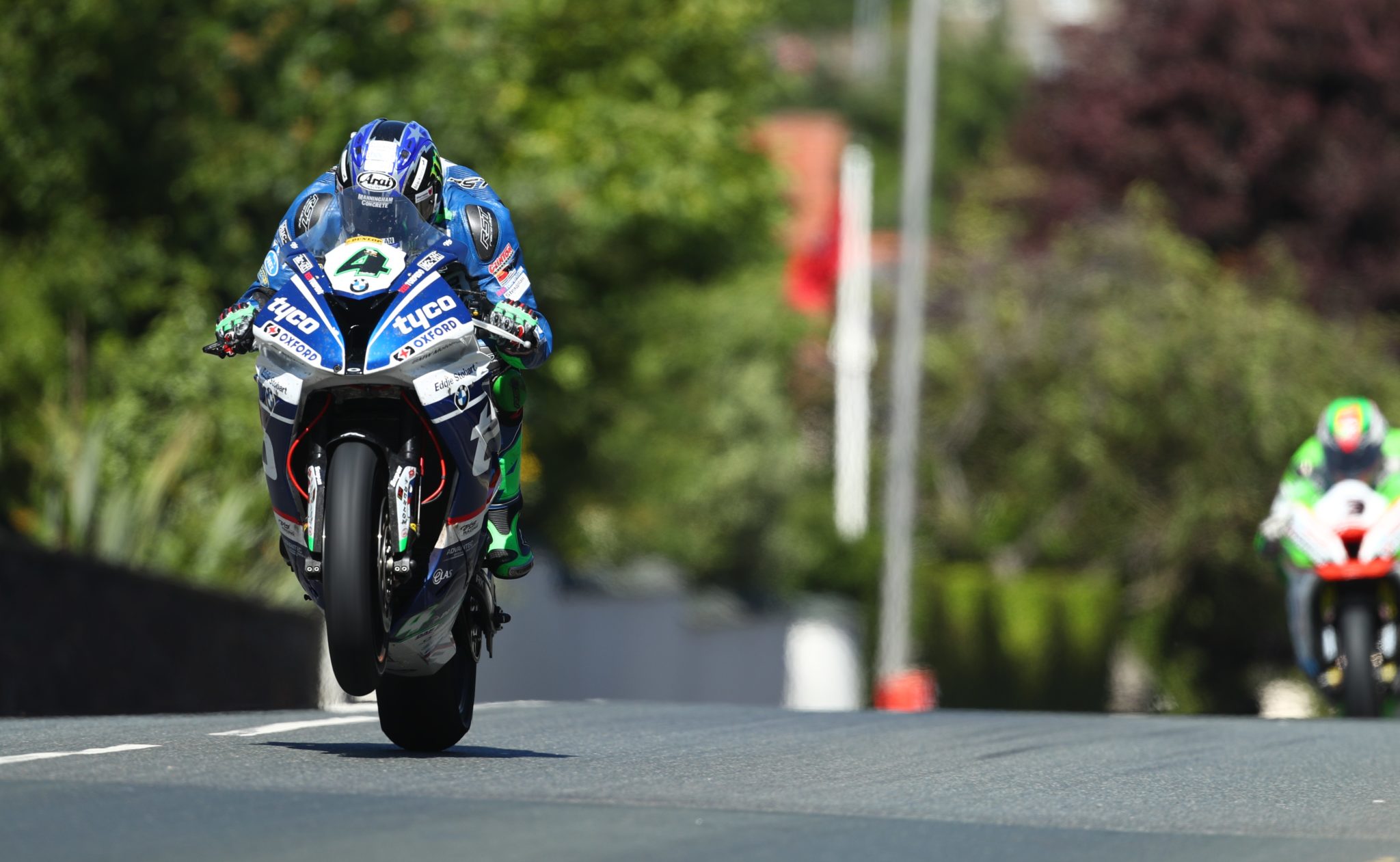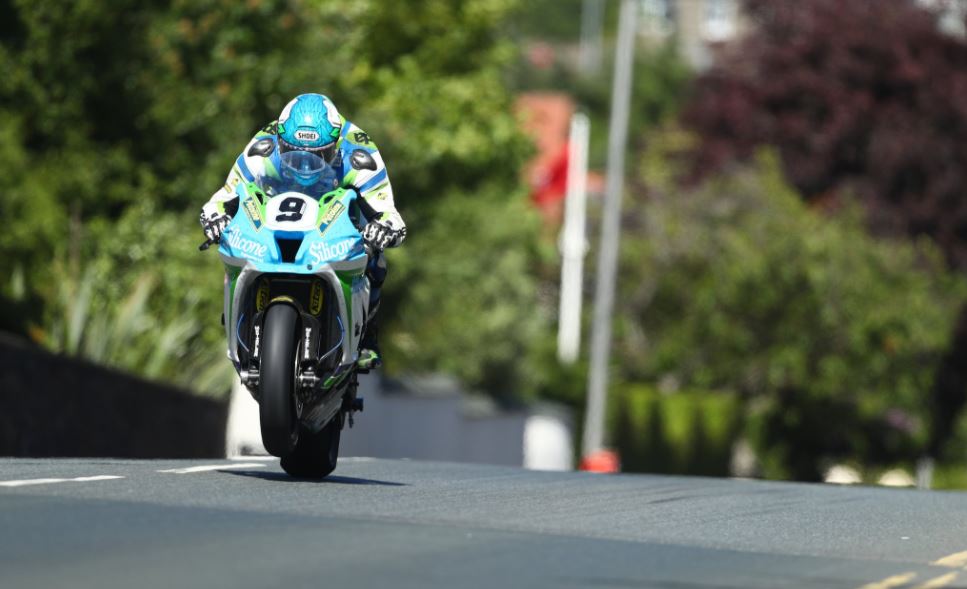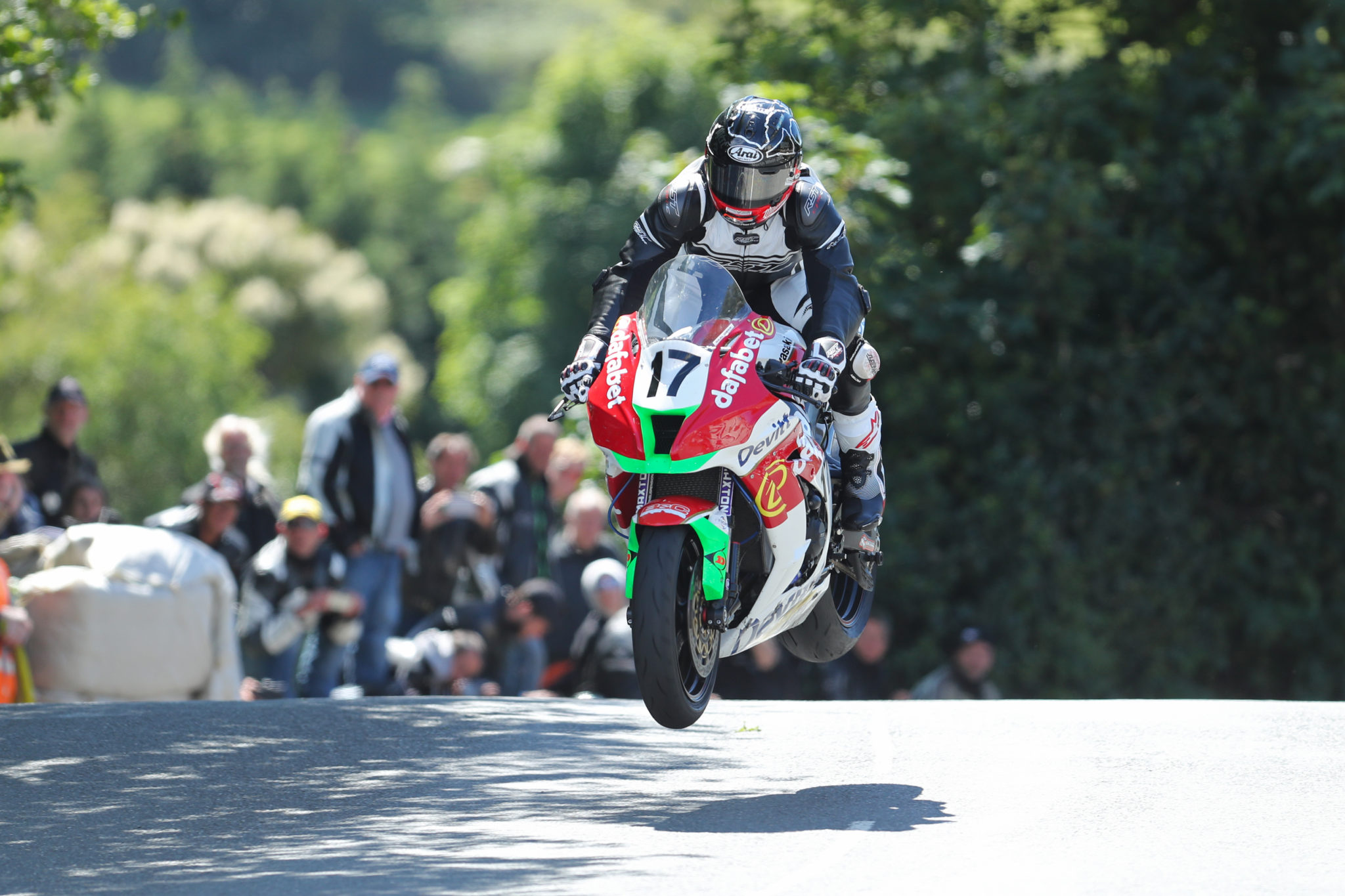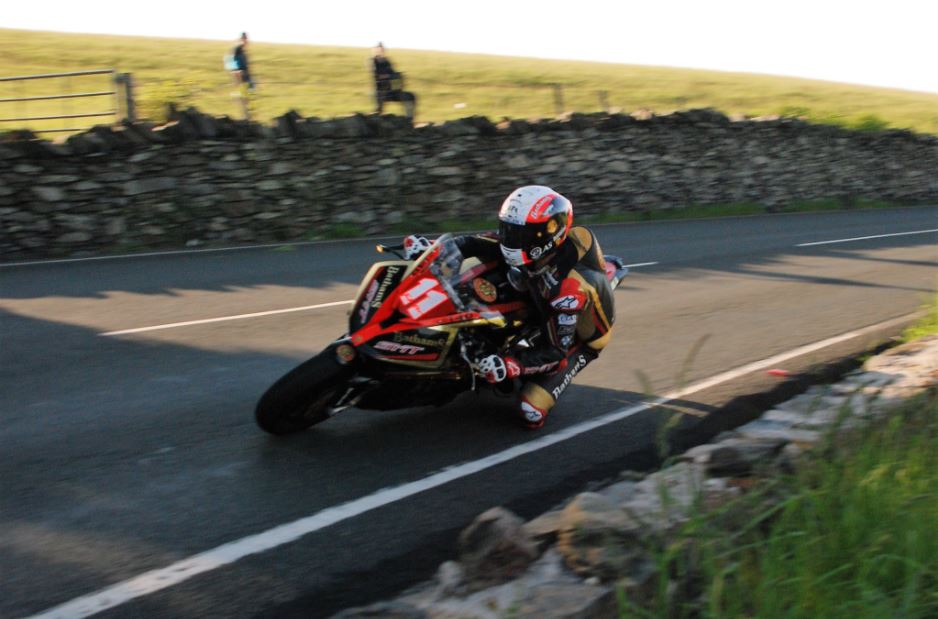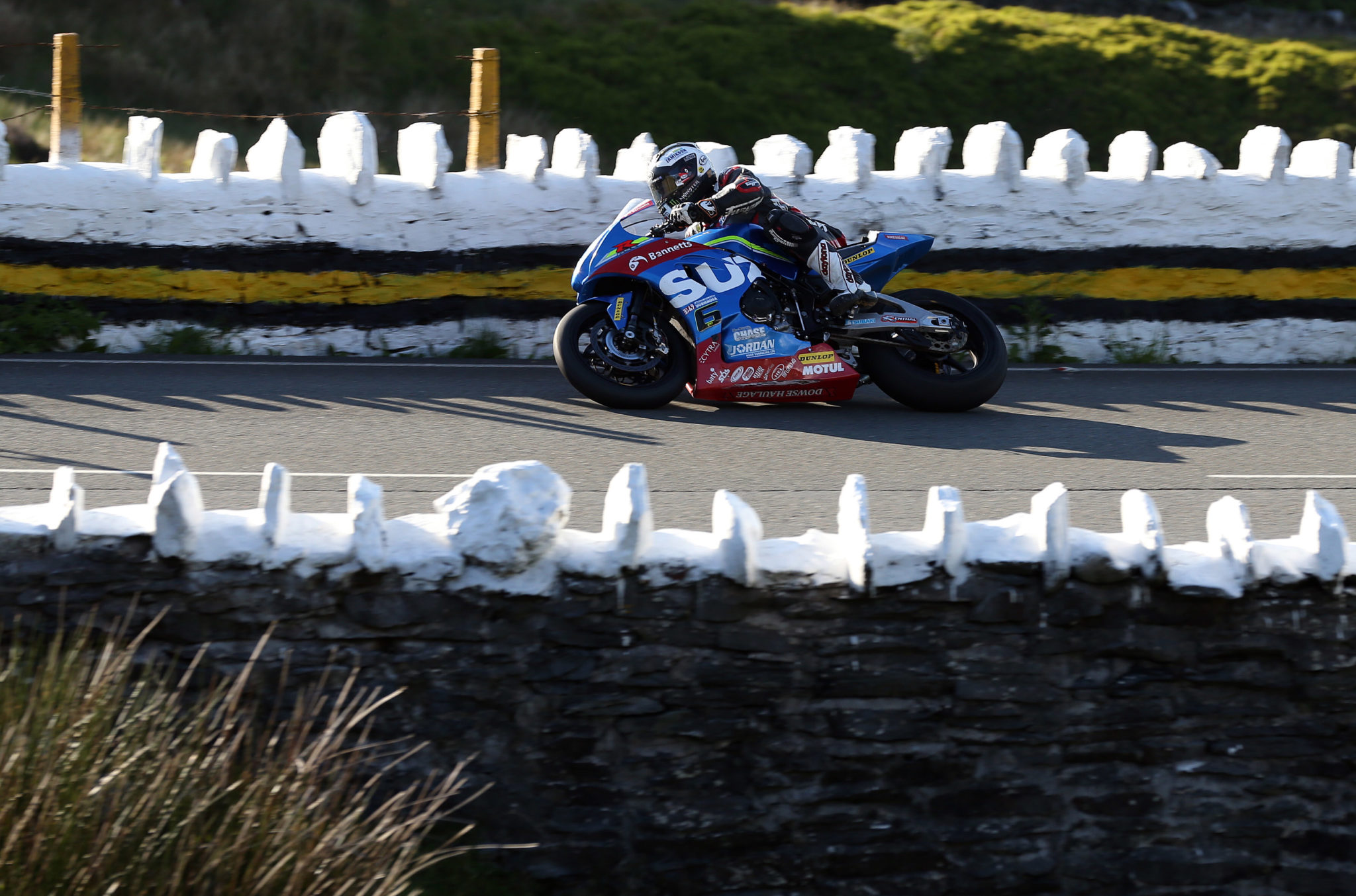The International Isle of Man TT (Tourist Trophy) races are an annual motorcycle road racing event held on the Isle of Man, traditionally in the last week of May and first week of June. The former sees practice take place with the latter seeing a full week of racing, with ten races now taking place – Superbike, Senior, Superstock 1000cc (x2), Supersport 600cc (x2), Supertwin (x2) and Sidecars (x2) – with many supporting attractions and gatherings taking place across the island.
For many years regarded as the most prestigious and oldest motorcycle race in the world, the origins of the races can be traced back to 1906 when the International Cup for Motor Cycles held in Austria, was plagued by accusations of cheating and sharp practices. A conversation on the train journey home between the Secretary of the Auto-Cycle Club, Freddie Straight, brothers Charlie and Harry Collier from the Matchless motorcycle company and the Marquis de Mouzilly St. Mars, led to a suggestion for a race in the following year for road touring motorcycles to be held in the Isle of Man based on the car races on closed public roads.
How it all began
The new race was proposed by the Editor of The Motor Cycle magazine at the Auto-Cycle Club annual dinner held in London on 17 January 1907. It was proposed that the races would run in two classes with single-cylinder machines to average 90 mpg and twin-cylinder machines to average 75 mpg fuel consumption. To emphasise the road touring nature of the motorcycles there were regulations for the inclusion of saddles, pedals, mudguards and exhaust silencers.
The first TT race was subsequently held on Tuesday 28 May 1907 and was organised by the Auto-Cycle Club over 10 laps of the St John’s Short Course, which was 15 miles in length and on the west side of the island. Apart from the two World Wars, 1915-1919 and 1940-1946, the Foot and Mouth epidemic of 2001, and the Covid-19 pandemic in 2020-21, the races have been held every year since.
The iconic and legendary TT has evolved dramatically over the years, check out this short video.
The first Isle of Man TT Race in 1907 was for two different classes of touring motor-cycles. The winner of the single-cylinder class, and overall winner of the first event was Charlie Collier riding a Matchless and he completed the 10-lap race in a time of 4 hours, 8 minutes and 8 seconds at an average race speed of 38.21 mph. The winner of the twin-cylinder class was Rem Fowler riding a Norton at an average race speed of 36.21 mph.
The trophy presented to Collier was donated by the Marquis de Mouzilly St. Mars and featured a stylised version of Olympic God ‘Hermes’ by Giovanni Da Bologna as a silver figurine astride a winged wheel. The trophy, now 108 years old, is now presented annually to the winner of the Senior TT race with its value simply described as priceless.
Run in a time-trial format, which now sees riders set off at ten-second intervals, the races switched to the Snaefell Mountain Course in 1911, a punishing 37.73-mile course consisting of a number of the island’s main public roads closed for racing.
Starting at the island’s capital of Douglas on the south-east coast, the course takes a wide sweep to the west and then turns right, heading north to the town of Ramsey. It then returns to Douglas going up and down the Snaefell Mountain climbing from sea level to an altitude of over 1300 ft (396m). A single lap sees riders tackle in excess of 200 bends with the course incorparating roads used every day by the public but closed for the racing and practice sessions.
Post World War 1
After the First World War, racing resumed in 1920 with the only changes being competitors now turned left at Cronk ny Mona, going through the tricky Governor’s Bridge section and then back to the start and finish line on Glencrutchery Road. This lengthened the course to 37.73-miles and, with the exception of resurfacing work, is the identical course that is still used today winding its way along narrow, twisting roads and streets flanked by walls, buildings, kerbs, trees, bridges and posts.
In 1949, the TT Races were chosen to host the British round of the inaugural FIM Motorcycle Grand Prix World Championships, something they did until 1976 with the races playing host to some of the greatest names in racing including Geoff Duke, John Surtees, Bob McIntyre, Mike Hailwood, Phil Read and Giacomo Agostini.
During this period, a third course – the 10.79-mile Clypse Course – was used to host the 125cc, 250cc and Sidecar races but only from 1954 until 1959 with 1960 seeing all racing return to the Mountain Course.
Check out Mike ‘The Bike’ Hailwood in action…
Concerns over safety
As the decades wore on, riders began to express, and increase, their concerns over the safety of the course, and others, being used for a World Championship race. The early 1970s saw many of the leading riders boycott the event and as a result the last World Championship round took place in 1976, reverting to Silverstone on the mainland in 1977.
Many thought this significant loss would spell the end of the TT but the races continued independently, initially forming part of the World Formula One Championship which ran from 1977 until 1990. Names like Joey Dunlop, the greatest TT racer ever with a record 26 wins, Phillip McCallen, David Jefferies, John McGuinness, Michael Dunlop and Ian Hutchinson came to the fore.
However, since then the TT has been a stand-alone event and whilst its experienced some challenging times over the years, its standing now is arguably as high as it’s ever been if not higher. Entries continue to be oversubscribed with attendances continuing to rise as fans flock to the island from all four corners of the globe.
And the records on the track continue to be broken too with the outright lap record now standing to Peter Hickman at 16m36.115s, a phenomenal 136.358mph.
Check out our TT gallery…
TT Milestones
There’s no surprise that the Isle of Man TT has some impressive milestones set over the last 100 years…
1904 – Motor racing comes to the Isle of Man as the Gordon Bennett car trials are held. The Manx Government introduces new legislation enabling public roads to be closed for racing.
1907 – The first TT races are held in the Isle of Man and take place on a triangular course in the west of the Island with the start being at St Johns. At Ballacraine, riders turn left and follow the current course as far as Douglas Road Corner in Kirk Michael where they turn left and follow the coast road to Peel before turning left again to complete the lap at St Johns.
Two races are held with Rem Fowler winning the twin cylinder class and Charlie Collier the single cylinder class. Fowler takes the overall fastest lap at 42.91mph.
1911 – The TT Races move onto the Mountain Circuit with the Junior and the Senior races taking place. The Junior is won by P.J. Evans and the Senior by Oliver Godfrey whilst Frank Phillips sets the fastest lap on his Scott at 50.11mph.
1914 – Racing is suspended on the Mountain Circuit following the outbreak of the First World War and does not return until 1920.
1922 – Race organisers add a 250cc class as Alec Bennett sets a new lap record in the Senior at 59.99mph.
1923 – Dubliner Stanley Woods chalks up the first of his ten TT victories in the 350cc race. The first running of a sidecar race takes place being won by Freddie Dixon but is removed from the programme after the 1925 event.
1926 – Jimmy Simpson clocks the first 70mph lap and five years later becomes the first to lap at 80mph. He had earlier had the honour of being the first to break the 60mph mark.
1937 – Freddie Frith breaks the 90mph barrier, lapping at 90.27mph in the Senior races. Omobono Tenni becomes the first foreign rider to win a TT when he takes the Lightweight.
1939 – Stanley Woods clocks his tenth and final TT victory whilst Georg Meier wins the Senior on a supercharged BMW. The outbreak of the Second World War sees racing suspended until 1947.
1949 – The TT meeting is included in the inaugural FIM motorcycle World Championships.
1950 – Geoff Duke wins the first of his five International TT victories, also raising the lap record to 93.33mph
1954 – The Clypse course is introduced and hosts 125cc and sidecar races until 1959. From 1955, 250cc races are also staged on the 10.92-mile circuit.
1957 – Scottish ace Bob McIntyre gets his name in the history books as he becomes the first man to lap the TT circuit at more than 100mph. He takes a Senior-Junior double on Gileras.
1961 – Mike Hailwood records the first of his 14 victories and becomes the first rider to notch up three victories in a week, one of which is taken on a Honda, the first win for the Japanese manufacturer.
1965 – Giacomo Agostini makes his TT debut.
1967 – Hailwood and Agostini go head to head in the Senior, which many believe to be the greatest ever TT race. Victory goes to Hailwood along with a new lap record of 108.77mph which stands for eight years.
1972 – Agostini wins the last of his ten victories as the tragic death of close friend Gilberto Parlotti prompts him to quite racing on the Mountain Course, citing it as too dangerous for the World Championship. Many of the top GP riders follow suit and quit the TT.
1975 – Mick Grant, riding a two-stroke triple Kawasaki, claims the outright lap record with a speed of 109.82mph.
1976 – A watershed year as the island hosts the British Grand Prix for the final time. William Joseph Dunlop makes a low key debut as John Williams shatters Grant’s one-year old lap record with a lap of 112.27mph on his RG500 Heron Suzuki.
1977 – Joey Dunlop storms to victory in the Jubilee race, the first of his 26 wins. Phil Read returns and claims a Formula One-Senior double whilst the Silver Jubilee year also sees the first 100mph lap in the sidecar race by Dick Greasley/Mick Skeels.
1978 – TT hero Hailwood returns after an 11-year absence and wins the Formula One race to become World Champion again. Pat Hennen records the first sub-20 minute lap only to crash heavily at Bishopscourt sustaining injuries that end his career.
1979 – Hailwood claims his 14th and final TT win and narrowly misses a 15th victory when Honda’s Alex George defeats him in the Classic race by 3.4s.
1980 – Joey Dunlop posts the first 115mph+ lap on his way to winning the Classic race.
1982 – Jock Taylor claims his 4th TT win and sets a new outright lap record in the sidecar class at 108.29mph.
1984 – Dunlop and McElnea shatter the lap record, both lapping in excess of 118mph, but the latter claims a Senior-Classic double on his Heron Suzuki’s.
1985 – Dunlop survives a sinking boat on his way the island to take his first hat-trick of wins.
1987 – Steve Hislop takes the first of his 11 wins with a dominant victory in the F2 race.
1988 – Dunlop takes his sixth consecutive F1 race and his second hat-trick to move on to 13 wins but fellow Ulsterman Steve Cull claims a new outright lap record with a speed of 119.08mph.
1989 – Hislop takes over the works Honda’s from an injured Dunlop and scorches to a hat-trick of wins, also setting the first 120mph+ laps. Manxman Dave Molyneux claims his first sidecar win.
1992 – Riding a Yamaha, Carl Fogarty raises the lap record to 123.61mph but finishes second to Hislop in the Senior race, Norton’s first win in the race since 1961. Joey Dunlop draws level with Mike Hailwood’s tally of 14 wins.
1993 – Joey Dunlop breaks Mike Hailwood’s record number of wins with his 15th victory coming in the 125cc race.
1996 – Phillip McCallen becomes the first man to win four races in a week as Dave Molyneux/Peter Hill post the first ever 110mph sidecar lap.
1999 – Molyneux raises the sidecar lap record to 112.76mph but Jim Moodie grabs the headlines, smashing Carl Fogarty’s seven year old lap record with a new mark of 124.45mph. A new star is born as David Jefferies takes his first hat-trick whilst John McGuinness claims his first win.
2000 – Dunlop takes his third hat-trick – and his first F1 race since 1988 – to move onto a yet to be beaten total of 26 wins. Jefferies also notches up a hat-trick and sets a new lap record of 125.69mph, the first 125mph+ lap.
2001 – The TT races are cancelled for the first time ever due to the Foot and Mouth epidemic.
2002 – Jefferies takes his third successive hat-trick and smashes his own lap record in the Senior with a stunning 127.29mph.
2003 – The TT is overshadowed by the death of Jefferies during Thursday afternoon’s practice session but TAS Racing continue and Adrian Archibald claims an F1-Senior double.
2004 – McGuinness sets a new outright lap record and records his first hat-trick whilst Molyneux, with Dan Sayle in the chair, takes his first double since 1996.
2005 – McGuinness takes two more wins with the sidecar victories shared between local drivers Molyneux and Nick Crowe, the former lapping at an incredible 116.04mph.
2007 – The TT celebrates its 100th year and McGuinness ensures there’s another historic moment as he records the first ever 130mph lap on his way to winning the Senior. Crowe and Dan Sayle set a new sidecar lap record at 116.67mph but it’s Molyneux who’s victorious in both races.
2008 – 125cc and 250cc races are re-introduced but held on the 4.25-mile Billown circuit in the south of the island. They last for just two years. Aussie Cameron Donald takes two victories on the Mountain Course.
2009 – McGuinness goes quicker again at 131.578mph whilst history is made with the first ever TT race for electric-powered motorcycles. Michael Dunlop takes his first TT win.
2010 – Ian Hutchinson creates history as he becomes the first rider to win five TT’s in a week. Former World Champion Klaus Klaffenbock claims both sidecar victories to be the first Austrian winner since 1954.
2011 – 100 years of racing on the Mountain Course is celebrated with McGuinness taking yet another Superbike-Senior double.
2012 – For the first time ever, the Senior race is cancelled as bad weather intervenes. Ryan Farquhar wins the re-introduced Lightweight race, now for Supertwin-specification machines.
2013 – McGuinness increases his outright lap record to 131.671mph but Michael Dunlop claims all the headlines with four wins. World Champions Tim Reeves and Ben Birchall share the sidecar spoils.
2014 – For the second year in a row, Dunlop takes four wins whilst Bruce Anstey sets a new lap record of 132.298mph, becoming the first man to break the 132mph mark in the process. McGuinness takes his 21st win with Molyneux moving onto a total of 17 after yet another sidecar win.
2015 – McGuinness wins two more races to move on to 23 in total, also setting a new lap record of 132.701mph. Ian Hutchinson wins three races, his first victories since 2010 whilst Dave Molyneux reclaims the sidecar lap record.
2016 – Michael Dunlop wins the Superbike and Senior TT races and becomes the first rider to lap the Mountain Course in under 17 minutes and at more than 133mph, setting a new outright lap record of 133.962mph. Hutchinson takes another hat-trick and sets the first ever 133mph lap on a Superstock bike. The Birchalls set a new sidecar lap record.
2017 – Hutchinson and Dunlop take two more wins each to move on to 16 and 15 victories respectively. The Birchalls take a sidecar double and increase their lap record to 117.119mph, the first lap ever in excess of 117mph. The second Supersport race is cancelled due to weather and becomes only the third race (after the 1987 Production and 2012 Senior) to be cancelled.
2018 – superb weather sees lap and race records broken in every class with firstly Dean Harrison and then Peter Hickman claiming the outright lap record, the latter the first man to lap the Mountain Course at more than 135mph after a lap of 135.452mph in the Senior.
The Birchalls increased their sidecar lap record to 119.250mph whilst Michael Dunlop took another hat-trick to move onto 18 TT wins, the third highest total ever.
2019 – Peter Hickman takes a hat-trick of wins but Dean Harrison wins the Senior TT, Michael Dunlop takes his 19th TT win with victory in the Lightweight race for the second successive year whilst the Birchalls make it ten sidecar wins in total and set a new race record.
Tom Birchall’s ten make him the most successful passenger in TT history and for the first time ever, five races took place on one day. Michael Rutter set a new TT zero lap record of 121.909mph.
2020/21 – No TT takes place due to the Covid-19 pandemic.
2022 – racing returns with Peter Hickman becoming just the fourth rider – after Philip McCallen, Ian Hutchinson and Michael Dunlop – to win four races in a week, victory coming in the Superbike, Superstock, Lightweight and Senior races. Michael Dunlop takes both Supersport victories to increase his overall tally to 21 whilst the Birchalls again do the double in the Sidecar class to move on to 12 career wins.
2023 – a new 10-race schedule sees Peter Hickman and Michael Dunlop win four races each with Hickman setting a new outright lap record of 136.358mph in the second Superstock race. Dunlop recorded the first ever 130mph lap in the Supersport class and his victories moved onto a career total of 25, just one behind the record held by his uncle Joey. The Birchalls take another Sidecar double and recorded the first ever 120mph lap on three wheels, setting a new lap record of 120.645mph.
2024 – Michael Dunlop wins four more races to move on to a career total of 29 and become the most successful TT rider ever, overhauling the 26 wins of his Uncle Joey. Davey Todd takes two wins, his first TT victories with Peter Hickman’s Superbike success seeing him draw level with Mike Hailwood on 14 wins. Manx duo Ryan and Callum Crowe win both sidecar races with Dave Molyneux taking his 31st and final TT podium with third in race two.
Now you know the phenomenal history of the Isle of Man TT, check out the records and stats that have been set over the past hundred years…
Words by Phil Wain.

